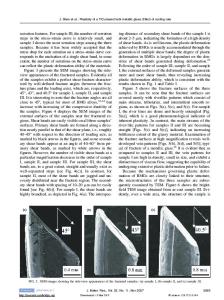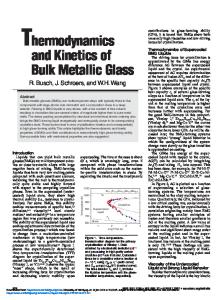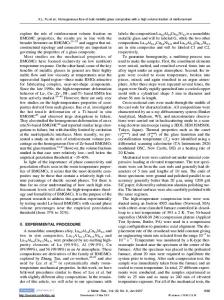Rate Dependence of Serrated Flow During Nanoindentation of a Bulk Metallic Glass
- PDF / 94,520 Bytes
- 4 Pages / 612 x 792 pts (letter) Page_size
- 8 Downloads / 385 Views
Y. Kawamura Department of Mechanical Engineering and Materials Science, Faculty of Engineering, Kumamoto University, Kumamoto, 860, Japan (Received 8 January 2002; accepted 8 April 2002)
Plastic deformation of Pd–40Ni–20P bulk metallic glass (BMG) was investigated by instrumented nanoindentation experiments over a broad range of indentation strain rates. At low rates, the load–displacement curves during indentation exhibited numerous serrations or pop-ins, but these serrations became less prominent as the indentation rate was increased. Using the tip velocity during pop-in as a gauge of serration activity, we found that serrated flow is only significant at indentation strain rates below about 1–10/s. This result suggests a transition in plastic flow behavior at high strain rates, in agreement with prior studies of BMGs under different modes of loading. I. INTRODUCTION
Although bulk metallic glasses (BMGs) exhibit desirable room-temperature strength, typically near 2 GPa, plastic strain in these materials is carried by narrow bands of shear localization. In tension, this shear banding leads to low ductility and rapid shear-off failure along a single plane inclined to the stress axis.1 In other modes of loading, shear bands appear to nucleate and propagate in discrete bursts, giving rise to rapid plastic strain development at a critical stress level. For example, after the yield stress has been reached during quasi-static compression of Pd- or Zr-based BMGs, serrated plastic flow is observed, where the stress-strain curve is not smooth, but punctuated by many small load drops.2–6 These serrations have been correlated with the motion of individual shear bands through the specimen, where each contributes a small increment of plastic strain to the macroscopic stress–strain curve.2 The importance of shear bands in plastic deformation of BMGs is emphasized by recent results on BMG composite materials, where the interception of shear bands by a dispersed second phase impacts the global deformation response and can substantially increase tensile ductility.7–9 Although serrated flow of BMGs is most commonly observed under uniaxial compression,2–6 it has also been observed under more complex stress states. For example, Kimura and Masumoto10,11 have measured displacement bursts during mode-I crack opening experiments on a Pd– 6Cu–16Si amorphous metal, and observed the development of shear bands on the exposed surfaces of specimens during testing. In a J. Mater. Res., Vol. 17, No. 7, Jul 2002
http://journals.cambridge.org
Downloaded: 14 Mar 2015
separate work, these authors found similar results during a mode-III tear test of thin amorphous metallic ribbons.12,13 Kimura and Masumoto4,10–13 also demonstrated that plastic deformation by shear band propagation follows an Arrhenius-type kinetics and that flow serrations disappear at high rates of displacement. This suggests that shear band nucleation/propagation is a rate-dependent process. Recent investigations by Wright et al.2 and Golovin et al.14 have pointed out that nano
Data Loading...











